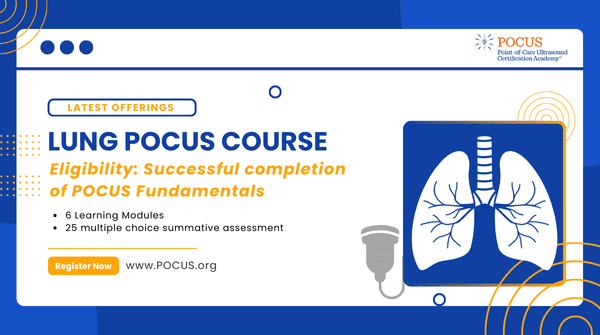There was a time when using ultrasound to assess the lung was considered altogether ineffective. This reasoning stemmed from the fact that ultrasound energy dissipates rapidly by air; therefore, imaging was not beneficial for evaluating the lungs. Basically, airflow was the primary determinant for lung assessment via ultrasound. Air creates an ultrasound beam reflection and impacts image quality, decreasing assessment accuracy.
Today, lung ultrasound (LUS) has evolved away from this thinking. The move has progressed towards the revolutionary approach of imaging the pulmonary parenchyma using point-of-care ultrasound (POCUS). Despite the limitations that air presents, LUS has proven valuable in evaluating several acute and chronic conditions. This includes:
- Cardiogenic pulmonary edema
- Acute lung injury
- Pneumothorax
- Pneumonia
- Interstitial lung disease
- Pulmonary infarctions and contusions
Numerous LUS studies predicted that point-of-care LUS would become particularly vital in various clinical settings, including the emergency room, intensive care unit, cardiology, and pulmonology and nephrology wards. Predication more than came true. This form of ultrasound indeed picked up steam, not only in popularity but in reliability. The introduction of the coronavirus quickly put LUS in the spotlight.
A common condition experienced by patients with COVID-19 is hypoxemia caused by low levels of oxygen in the blood. The result is increased total ventilation, causing the patient to develop severe hypocapnia. A full assessment is then required, traditionally conducted via a clinical examination of the respiratory system utilizing a stethoscope. However, certain circumstances surrounding COVID-19 made LUS a more attractive option. Considering the high incidence of interstitial changes and respiratory failure and the risk of cross-infection that could occur utilizing the same modality from one patient to the next, the stethoscope heightened safety concerns.
POCUS proved to be an effective alternative for protecting and monitoring patients. This portable option provided healthcare providers with a method of obtaining swift answers safely. CT scans, carted ultrasound machines, or transferring patients to radiology for a lung examination became time-consuming amid the influx of those needing care. Also, each modality form listed requires deep cleaning, taking anywhere from 60-120 minutes. Because of its pocket size, POCUS only requires a sterile probe sheath and wiping down the designated smart device after use. This ease of cleaning became significantly crucial during a high infectiousness time.
POCUS is used to track the development of COVID-19 in those infected. The virus concentrates on the lungs’ peripheral regions, which can be distinctly seen via imaging. The modality can predict when symptoms will amplify up to 12-24 hours before occurring—obtaining this kind of insight allows providers to take a proactive approach. Treatment plan adjustments are made ahead of time, arming frontline workers with a strategy for combating the virus. In short, POCUS has become an indispensable weapon in the war on COVID.
The LUS evolution continues to be discussed and explored. Dr. Libertario Demi, Associate Professor at the University of Trento, Department of Information Engineering and Computer Science, and Head of ULTRa (Ultrasound Lab Trento), joins us at the 2022 POCUS World Conference to present on the latest developments in the field of LUS. His current research focuses on signal processing, image formation, and image analysis with a particular concentration on active lung ultrasound imaging. He’ll share with attendees the development of a method fully dedicated to diagnosing and monitoring lung diseases, beginning with COVID-19.
Discussions in the field doesn’t end here.
There is no mistaking that LUS is a rapidly growing field taking flight during the current pandemic. Concerns persist surrounding its ability to cope with the high air content in lung tissues. Although clinicians globally have employed LUS to assess various lung conditions, including patients suspected and/or affected by COVID-19, questions still remain. The continued conversation is centered on several aspects requiring the attention of the technical and clinical world. This focus includes standardization and quantitative approaches. Both remain limitations for LUS presently. In several weeks at the 2022 POCUS World Conference, Dr. Demi will assist attendees with drawing a more defined picture. Additionally, the POCUS community attending will engage in standards discussions.
LUS has increased supporters, and a great deal of thanks goes to its impacts made during the current pandemic. It has been and continues to be a valuable aid in diagnosing lung diseases. To further its growth and usage, clinicians and technical experts must cooperate to standardize image acquisition protocols and analysis tools. The inability to collaborate side by side will harm the credibility of LUS, only hindering the exploitation of its full potential. Learning from pioneers like Dr. Demi and other passionate experts whose studies aimed at investigating LUS will ensure its continual advancement.
Learn how you can join in this medically altering development at our global convening of brilliant POCUS minds.
Interested in learning more about POCUS lung assessment? Explore our library of educational resources to access a wealth of tools to support your own development.





















